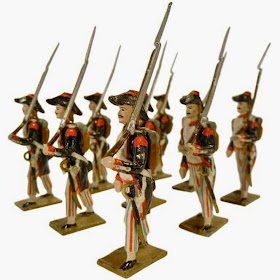 |
| TOY SOLDIERS |
Like their human counterparts, toy soldiers have inherited the rare ability to find loyal and dedicated admirers. While some enthusiasts may search for rare pieces dating from Frederick the Great's reign, or a particularly famous mark from France or England, others may find re-creating a particular historical battle, complete with weaponry, more enjoyable.
I he first group will consider factors like age, condition and sometimes, original packaging. Those who collect models for war games may look for soldiers made from various materials, or ones that have been adapted and repainted. The 1960s saw a rise in the popularity of collecting toy soldiers and through their long and distinguished history, they have continued to evolve and develop to meet the requirements of a new generation of enthusiastic children and adults.
 |
| TOY SOLDIERS |
Molds for these flat soldiers were generally in two parts and made from stone, with appropriate detailing either carved or etched out. Quality varied tremendously; from stiff and barely life-like to beautifully detailed examples.
The output of the Hilpert familv (1720 1822) is particularly prized lor their highly detailed and very beautiful figures. These early examples are generally much larger (160mm high), since manufacturers had no shared rules for size. It was not until the mid-19th century that the standard of 30mm, known as the Nuremberg Scale, was adopted.
 |
| TOY SOLDIERS |
One German maker, Heinrichsen, created soldiers and battles from Greek and Roman antiquity, as well as figures of more recent armies and their battles. It is his name, and that of Hilpert, that are the only well known makers of flat soldiers in Germany. Most were made without any identifying mark and later examples were sold by weight, rather than by piece.
As a rule, the more detailed and elaborate flat soldiers appear and the more artistry apparent in their painted surface, the higher their value.
 |
| TOY SOLDIERS |
Solid soldiers
While the French controlled a smaller part of the toy soldier market, they were responsible for an important innovation of the late-18th century known as RonJ Bouse. Produced by Lucotte, the most famous French manufacturer of this type, the manufacturing process used a two- piece bronze mold that was filled with molten lead. Heads were simply plugged into bodies. Lucotte soldiers are easy to recognise, since they carry both the letters LC and an Imperial bee.
In 1825, Lucotte was taken over by Mignot. Their soldiers carry the initials CBG for the founders, Cuperlv, Blondel and Gerbeau. Mignot soldiers arc 500mm 600mm high, when measured from the top of the base to the forehead whereas today, 540mm is the standard height for toy soldiers.
George Heyde of Dresden also produced solid figures from 1840 1944.
 |
| TOY SOLDIERS |
The firm had no standard size and many of their figures stand just 45mm high. While Mignot generally confined their output to traditional battle settings, Heyde created very large sets that included soldiers in action, as well as figures of women. These include nurses who clearly entertained and offered solace to soldiers when they were absent from the more serious duties of battle. The figures were made in several sections so that bodies and heads could be plugged together. Riders were then fixed to their mounts with small pegs.
Part 1 TOY SOLDIERS
Part 2 CLASSIC TOY SOLDIERS
part 3 PLASTIC TOY SOLDIERS
Collectibles Coach


No comments:
Post a Comment